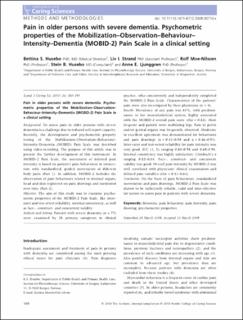| dc.contributor.author | Husebø, Bettina S. | |
| dc.contributor.author | Strand, Liv I. | |
| dc.contributor.author | Moe‐Nilssen, Rolf | |
| dc.contributor.author | Husebø, Stein B. | |
| dc.contributor.author | Ljunggren, Anne E. | |
| dc.date.accessioned | 2020-07-09T13:24:17Z | |
| dc.date.available | 2020-07-09T13:24:17Z | |
| dc.date.issued | 2010 | |
| dc.identifier.citation | Husebø, B.S., Strand, L.I., Moe-Nilssen, R., Husebø, S.B. og Ljunggren, A.E. (2010): Pain in older persons with severe dementia. Psychometric properties of MOBID-2 Pain Scale in a clinical setting. Scandinavian Journal of Caring Sciences 24(2), 380–391. | en_US |
| dc.identifier.uri | https://hdl.handle.net/11250/2661876 | |
| dc.description.abstract | Background: To assess pain in older persons with severe dementia is a challenge due to reduced self‐report capacity. Recently, the development and psychometric property testing of the Mobilization–Observation–Behaviour–Intensity–Dementia (MOBID) Pain Scale was described using video‐recording. The purpose of this article was to present the further development of this instrument. In MOBID‐2 Pain Scale, the assessment of inferred pain intensity is based on patient’s pain behaviours in connection with standardized, guided movements of different body parts (Part 1). In addition, MOBID‐2 includes the observation of pain behaviours related to internal organs, head and skin registered on pain drawings and monitored over time (Part 2).
Objective: The aim of this study was to examine psychometric properties of the MOBID‐2 Pain Scale, like inter‐rater and test–retest reliability, internal consistency, as well as face‐, construct‐ and concurrent validity.
Subjects and Setting: Patients with severe dementia (n = 77) were examined by 28 primary caregivers in clinical practice, who concurrently and independently completed the MOBID‐2 Pain Scale. Characteristics of the patients’ pain were also investigated by their physicians (n = 4).
Results: Prevalence of any pain was 81%, with predominance to the musculoskeletal system, highly associated with the MOBID‐2 overall pain score (rho = 0.82). Most frequent and painful were mobilizing legs. Pain in pelvis and/or genital organs was frequently observed. Moderate to excellent agreement was demonstrated for behaviours and pain drawings (κ = 0.41–0.90 and κ = 0.46–0.93). Inter‐rater and test–retest reliability for pain intensity was very good, ICC (1, 1) ranging 0.80–0.94 and 0.60–0.94. Internal consistency was highly satisfactory; Cronbach’s α ranging 0.82–0.84. Face‐, construct‐ and concurrent validity was good. Overall pain intensity by MOBID‐2 was well correlated with physicians’ clinical examination and defined pain variables (rho = 0.41–0.64).
Conclusion: On the basis of pain behaviours, standardized movements and pain drawings, MOBID‐2 Pain Scale was shown to be sufficiently reliable, valid and time‐effective for nurses to assess pain in patients with severe dementia. | en_US |
| dc.publisher | Scandinavian Journal of Caring Sciences | en_US |
| dc.subject | dementia | en_US |
| dc.subject | pain behaviour | en_US |
| dc.subject | pain intensity | en_US |
| dc.subject | pain drawing | en_US |
| dc.subject | psychometric properties | en_US |
| dc.title | Pain in older persons with severe dementia. Psychometric properties of the Mobilization–Observation–Behaviour–Intensity–Dementia (MOBID‐2) Pain Scale in a clinical setting | en_US |
| dc.type | Journal article | en_US |
| dc.source.pagenumber | 380-391 | en_US |
| dc.source.volume | 24 | en_US |
| dc.source.journal | Scandinavian Journal of Caring Sciences | en_US |
| dc.source.issue | 2 | en_US |
| dc.identifier.doi | https://doi.org/10.1111/j.1471-6712.2009.00710.x | |
| dc.description.localcode | måsjekkes | |
